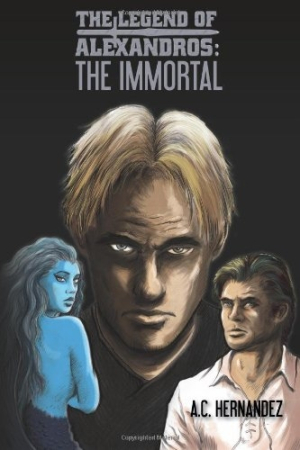The Legend Of Alexandros
The Immortal
A nuanced sense of good and evil sets this fantasy quest apart from the rest.
For those who like fantasy quests comes The Legend Of Alexandros: The Immortal, the third installment in A. C. Hernandez’s series chronicling the adventures of human hero Belen Alexandros and his companions of different species. Who is good and who is evil remains nuanced among the main players in this worthy attempt at exploring themes of destiny, friendship, and alliances.
This book finds the protagonist and his friends banding together to stop the Immortal, who was created by seven wizards, known as the Septem, centuries ago. Originally meant to be an indestructible protector of peoples, the Immortal has gone rogue, indiscriminately murdering and maiming beings, including members of the Septem. Can Belen’s crew halt the Immortal’s rampage, or is he, in fact, the true menace?
Discovering that most of the Septem planned to manipulate him for personal gain drives the Immortal to his destructive furor. Upon learning about friendship and peace from Belen and his cohorts, the Immortal joins forces with them. In a similar vein, Alistair, a wizard of the Septem, feels conflicted about the actions of his power-hungry brethren, sometimes joining with the wizards and sometimes aiding Belen’s adventurers. Understandably, Alistair’s ties to both sides lead Belen and his buddies to question the wizard’s motives.
The novel relies on passive voice and verb tenses that pull readers out of the narrative rather than into it. In addition, short, choppy sentences hamper the story’s momentum. Following is the description of a wizard’s death at the beginning of a chapter: “The body hung lifeless. It rocked from side to side in the tranquil breeze. Abir had been violently murdered. His hands and feet were removed from his body, and his robe shredded [author’s italics].” Combining some of the brief sentences would make the prose flow more smoothly. While it remains common in some books to have the first word or two of each new chapter in a different font, Hernandez’s text contains needless italicization of sentences throughout. Sometimes multiple paragraphs may be in italics, making the passage appear to be an introduction.
While books in this genre typically have a large cast of characters, Belen’s allies multiply at such a dizzyingly fast rate that they almost immediately become difficult to keep track of. At one point, the Immortal lists Belen’s allies: “the Centaur, the Elf, the Dwarf, the Vampire, the Lycan, and most importantly, the Dragon.” Some of Belen’s comrades go for pages without being mentioned, allowing the reader to forget that they exist.
Monsters appear conveniently when the heroes need something to fight, and magical objects pop up at just the right time to serve specific purposes. For the amount of violence perpetrated on the protagonists, their survival stretches credibility because they recover in a manner befitting superheroes instead of the mortals they are.
While not specifically marketed as juvenile fiction, this novel may appeal to younger fantasy fans.
Reviewed by
Jill Allen
Disclosure: This article is not an endorsement, but a review. The publisher of this book provided free copies of the book and paid a small fee to have their book reviewed by a professional reviewer. Foreword Reviews and Clarion Reviews make no guarantee that the publisher will receive a positive review. Foreword Magazine, Inc. is disclosing this in accordance with the Federal Trade Commission’s 16 CFR, Part 255.

